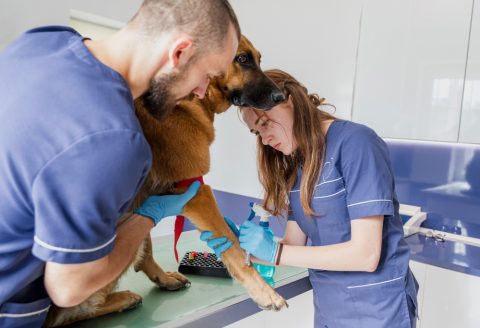Discovering that your canine companion’s eyes appear redder than normal can be concerning for any pet owner. While occasional eye redness might seem like a minor issue, it often signals underlying health conditions that require proper attention and care. The challenge lies in determining whether this symptom represents a temporary irritation or something more serious that demands immediate veterinary intervention.
Eye redness in dogs can stem from various causes, ranging from simple environmental irritants to complex medical conditions affecting vision and overall eye health. Understanding these different causes and their associated symptoms empowers pet owners to make informed decisions about their dog’s care and recognize when professional veterinary evaluation becomes necessary for their furry friend’s wellbeing.
Contents
Primary Causes of Canine Eye Redness
Identifying the root cause of your dog’s red eyes requires careful observation of accompanying symptoms and understanding the most common conditions that affect canine eye health. These causes vary significantly in severity and treatment approaches.
Inflammatory Eye Conditions
One significant cause of redness involves inflammation within the eye structure, particularly affecting the uvea, which includes the iris, ciliary body, and choroid. This inflammatory condition can develop in dogs of any age or breed, though certain breeds with prominent eye features may show increased susceptibility.
Dogs experiencing eye inflammation typically display obvious discomfort, often pawing at the affected eye or rubbing their face against furniture or carpeting. The inflammation may prevent normal eyelid closure, and affected dogs frequently show signs of pain through behavioral changes such as decreased appetite or reluctance to engage in normal activities.
The redness associated with inflammatory conditions often appears more intense than simple irritation, and the eye may feel warm to the touch. Pet owners should monitor their dog’s comfort level and seek veterinary care if the inflammation persists or worsens over time.
Physical Trauma and Injuries
Direct trauma to the eye area frequently results in noticeable redness, particularly when the injury affects only one eye. Common causes include scratches from other animals, contact with sharp objects during play, or accidents during outdoor activities.
Eye injuries often present with localized redness concentrated around the site of trauma. Pet owners may notice visible scratches on the eye surface, swelling around the eye area, or their dog showing reluctance to open the affected eye fully. Some injuries may cause discharge or tearing that differs from normal eye moisture.
Prompt veterinary attention becomes crucial for eye injuries, as even minor trauma can develop into serious infections or complications that threaten vision. Emergency veterinary care ensures proper wound assessment and prevents secondary problems that could arise from untreated injuries.
Allergic Reactions
Environmental and food allergies can manifest through eye redness, similar to how allergies affect human eyes. Seasonal allergens like pollen, grass, or mold spores commonly trigger allergic responses that include red, watery eyes.
Dogs with environmental allergies may show increased eye redness during specific seasons or after exposure to particular triggers. This type of redness often affects both eyes simultaneously and may be accompanied by other allergic symptoms such as sneezing, scratching, or skin irritation.
Food allergies can also contribute to eye redness, though this typically occurs alongside other systemic signs like poor coat quality, digestive issues, or skin problems. Identifying and eliminating allergens requires veterinary guidance and may involve dietary changes or environmental modifications.
Elevated Eye Pressure
Increased pressure within the eye, commonly known as glaucoma, represents a serious condition that can cause significant redness and discomfort. This condition develops when fluid drainage within the eye becomes impaired, leading to pressure buildup that can damage delicate eye structures.
Dogs with elevated eye pressure often display red eyes that may also appear swollen or unusually prominent. The affected eye might feel harder than normal when gently touched, and dogs frequently show signs of pain through behavioral changes or decreased activity levels.
Glaucoma can affect one or both eyes and may develop gradually or appear suddenly. This condition requires immediate veterinary attention, as untreated glaucoma can lead to permanent vision loss. Treatment options may include medications to reduce pressure or surgical interventions in severe cases.
Corneal Damage
The cornea, which forms the clear front surface of the eye, can develop ulcers or erosions that cause significant redness and discomfort. These corneal lesions typically result from injuries, infections, or underlying eye conditions that compromise the corneal surface.
Corneal ulcers often appear as cloudy or hazy areas on the eye surface, accompanied by redness and excessive tearing. Dogs with corneal damage frequently squint, blink excessively, or keep the affected eye closed due to pain and light sensitivity.
The severity of corneal ulcers varies considerably, with some requiring intensive treatment to prevent perforation or vision loss. Deep ulcers or those showing signs of infection demand immediate emergency veterinary care to preserve eye function and prevent complications.
Inadequate Tear Production
Insufficient tear production, known as dry eye syndrome, can lead to chronic eye redness and discomfort. Tears play a crucial role in maintaining eye health by washing away debris, providing lubrication, and delivering nutrients to eye tissues.
Dogs with dry eye syndrome often display persistent redness accompanied by thick, sticky discharge that differs from normal tears. The eyes may appear dull or lack their usual bright, moist appearance. Affected dogs frequently blink excessively or squint due to the uncomfortable sensation of dry eyes.
This condition can develop gradually, making it important for pet owners to monitor changes in their dog’s eye appearance and comfort level. Left untreated, dry eye syndrome can lead to corneal damage and vision problems, making early diagnosis and treatment essential for maintaining eye health.
Recognizing Urgent Situations
Certain combinations of symptoms indicate the need for immediate veterinary attention, regardless of the suspected underlying cause. Sudden onset of severe redness, particularly when accompanied by obvious pain, vision changes, or behavioral alterations, warrants emergency care.
Signs that require urgent veterinary evaluation include eyes that appear cloudy or hazy, pupils that don’t respond normally to light, or any signs of eye trauma. Additionally, if your dog shows signs of vision impairment such as bumping into objects or reluctance to navigate familiar spaces, immediate professional assessment becomes necessary.
Dogs experiencing severe eye pain may exhibit dramatic behavioral changes, including loss of appetite, hiding, or aggressive responses when approached. These signs indicate significant discomfort that requires prompt medical intervention to provide relief and prevent complications.

Professional Veterinary Assessment
Veterinary examination provides the most reliable method for diagnosing the cause of eye redness in dogs. Professional assessment includes specialized equipment and techniques that allow thorough evaluation of eye structures not visible during casual observation.
Veterinarians can perform tests to measure eye pressure, assess tear production, and examine internal eye structures to identify specific problems. They may also use special stains to highlight corneal damage or perform cultures to identify infectious organisms requiring targeted treatment.
Early veterinary intervention often leads to better treatment outcomes and can prevent minor issues from developing into serious complications. Regular eye examinations as part of routine veterinary care can also help detect developing problems before they cause obvious symptoms.
Treatment and Management Approaches
Treatment for eye redness varies significantly depending on the underlying cause, ranging from simple environmental modifications to complex medical or surgical interventions. Some conditions respond well to topical medications, while others may require systemic treatments or specialized procedures.
For allergic causes, treatment might include antihistamines, environmental changes, or dietary modifications. Infectious conditions typically require antimicrobial medications, while inflammatory conditions may benefit from anti-inflammatory treatments.
More serious conditions like glaucoma or corneal ulcers often require intensive treatment protocols that may include multiple medications, frequent monitoring, and possible surgical intervention. The key to successful treatment lies in accurate diagnosis and prompt initiation of appropriate therapy.
Preventive Care Strategies
While not all causes of eye redness can be prevented, certain measures can reduce the risk of eye problems in dogs. Regular grooming helps prevent hair from irritating the eyes, and keeping the eye area clean reduces the risk of infections.
Protecting dogs from potential eye injuries during play or outdoor activities, maintaining current vaccinations, and addressing allergies promptly can all contribute to better eye health. Regular veterinary check-ups allow early detection of developing problems before they become serious.
Pet owners should familiarize themselves with their dog’s normal eye appearance so they can quickly recognize changes that might indicate developing problems. Prompt attention to eye issues often leads to better outcomes and can prevent minor problems from becoming major complications that threaten vision or require extensive treatment.








